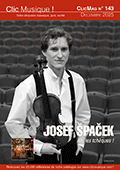 La sonate en trio est un pont aux ânes de la musique baroque. Deux instruments mélodiques, les violons, jouent alternativement soutenus par la basse. Avec ces six sonates à deux claviers et pédale, Bach importe le genre à l'orgue avec un objectif pédagogique car elles furent composées pour Wilhelm Friedemann. Leur difficulté d'exécution à fait dire à Albert Schweitzer qu'elles étaient « le gradus ad parnassum de tout organiste » et à Forkel plus sensible à l'exceptionnelle beauté de ces pages : « … de par leur beauté et leur nouveauté, elles surviveront à toute révolution musicale ». Last but not least, Ullrich Böhme a choisi de jouer les six sonates sur six orgues qui font partie de la crème des instruments de l'époque de Bach situés à Naumburg, Freiberg, Ottobeuren, Dresde et Leipzig. Un seul est de facture moderne, le Gerald Woehl's de St Thomas de Leipzig. Tous sont des orgues suffisamment complets pour pouvoir jouer les trois parties. Böhme a choisi ses tempi de façon à respecter l'acoustique des églises quitte aussi à transposer les parties de pédale (à Freiberg et Ottobeuren) en raison de claviers insuffisants. Ces prescriptions suffisent à comprendre la cohérence du projet de Böhme alliée à une grande rigueur d'exécution. Chaque registration est fondée sur la clarté et le respect des parties, l'articulation entre des deux voix et la basse, la mélodie et l'assise rythmique. Ainsi, le contrepoint est aiguisé, ciselé comme un diamant. Signalons la prise de son, précise et peu réverbérée, qui ne noient pas les sonorités des orgues mais en magnifie les qualités. Lecture pédagogique par sa probité mais aussi d'une superbe élégance. (Jérôme Angouillant)  The fine art of playing the exemplary organs of Bach’s time: Ullrich Böhme, the custodian of the organs at Bach’s long-time working place St Thomas in Leipzig, has recorded a new CD of the trio sonatas for organ. This recording meets the challenge of carving out the delicate qualities of the six sonatas by virtue of the tonal possibilities of outstanding period instruments, and undoubtedly serves as a reference in several ways. As his position suggests, Böhme directly refers to the 1730 autograph of the six sonatas and presents a relaxed and transparent rendition of the source – with the serenity of a l'art-pour-l'art work as well as the vitality and enthusiasm of a performer capable of translating this wonderful collection into play and sound. To this end Böhme chose some exquisite instruments mostly from Central Germany, some of which were built in Bach’s direct vicinity. The organ of St Wenceslas in Naumburg, completed by Zacharias Hildebrandt in 1746, is probably closest to Bach’s tonal preferences. It is proven that Bach was involved in the commission of this instrument. The newest instrument on the recording, built by Gerald Woehl in 2000, the year of the 250th anniversary of the death of Johann Sebastian Bach, is very similar in terms of style. It is based on a specification designed by Johann Christoph Bach I for the organ of St George’s Church in Eisenach. The two largest surviving instruments of Gottfried Silbermann in Freiberg Cathedral (1714) and in the Catholic Cathedral of Dresden (1750–55, finished by Hildebrandt) complete the selection of great Saxon baroque organs. In this setting, the Organ of the Holy Trinity in the Benedictine Abbey of Ottobeuren (1754–66) with its francophone character appears to be a rather unusual choice. However, its builder Karl Joseph Riepp was greatly inspired by Gottfried’s brother Andreas Silbermann, the “Alsatian Silbermann”, and created an instrument which – similarly to the others on this recording – boasts an almost endless range of timbres for rendering the wonderful chamber music of the six sonatas.
 |
